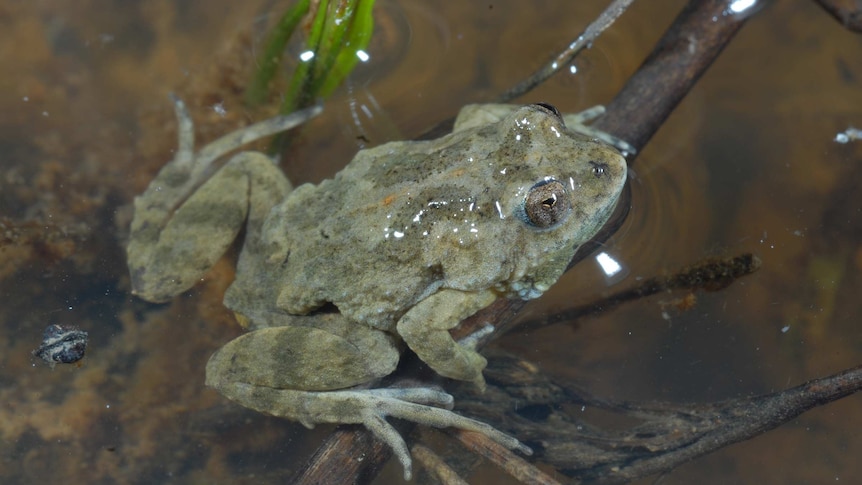Grazing cattle dot the horizon of the King Valley, between hollowed out gum trees and the foothills of the Victorian High Country. It’s a quiet spot, where a loud battle is taking place between farmers and developers spruiking a big solar farm, spanning an area the size of 280 fields the size of the Melbourne Cricket Ground. The proposed Meadow Creek Solar Farm, 27 kilometres east of Wangaratta, would span 566 hectares and generate 330 megawatts of power. Plans for its development were tracking well until the surprise discovery last year of the endangered Sloane’s froglet in the underlying ecosystem. Froglet’s habitat limited At just 10 millimetres in length, the Sloane’s froglet is tiny and its habitat is scarce. Damien Michael, a senior researcher and landscape ecologist at Charles Sturt University’s Gulbali Institute, said the frogs were “pretty important”. “If you think of a paddock that’s got little hummocks, that’s called a gilgai wetland. “Most people would just see a paddock and just think nothing of it. “But these gilgais have all these little, shallow depressions … that is [this frog’s] core, natural habitat, which is slowly being lost in the landscape … and populations have been declining.” Prime land for farming John Conroy from the Meadow Creek Agricultural Community Action Group said the presence of the frog, as well as the endangered bandy-bandy snake and the gang-gang cockatoo, was enough reason to call the project in for further assessment. He went to Canberra last week with a delegation of farmers to try to convince the Department of Climate Change, Energy, the Environment and Water (DCCEEW) to review the project through the lens of the Environment Protection and Biodiversity Conservation (EPBC) Act 1999. But Mr Conroy admits farmers and froglets are unlikely allies. “We’re generational farmers and we certainly care for the land — we’ve planted more trees than most over the years, but we certainly don’t take much notice of frogs,” he said. “What we see as unfit about the proposal is that it’s an entirely safe, drought-proof, reliable rainfall agricultural district that never has a failed season. “All the scientists are telling us that it’s going to get drier and warmer, we can’t understand why they wouldn’t be protecting the best agricultural regions for food production,” Froglet protection measures Federal Member for Indi Helen Haines said farmers were educated about the EPBC Act. Under the act, the group will aim to convince the DCCEEW that the solar farm is likely to have, a “significant impact” on the Sloane’s froglet. “[Now] they can put in their objections and submission into the process outlining where their concerns are on this particular project,” Ms Haines said. It’s a valuable avenue for the group, after third-party appeals against renewable energy projects to the Victorian Civil and Administrative Tribunal (VCAT) were banned by the state government in April. “It’s [now] a 14-day period for us to respond to three years of work that the proponents put into these applications with professional people, so it’s weighted heavily against us,” Mr Conroy said. “It seems pretty, outrageously unfair.” In a statement, a Meadow Creek Solar Farm spokesperson said measures to prevent habitat damage were being implemented and the Sloane’s froglet wasrecorded at only one of the seven survey locations. “Further protection measures for the gang-gang cockatoo include preserving woodland and riparian zones within the site and limiting tree removal across the site.” Property value fears Ross and Beverley Schutt have lived at their home at Milawa for almost 60 years and said they never expected a solar farm to be built across the road. Mr Schutt said he was concerned about the loss of farming land and a way of life in the region. “We’re on prime farmland … if these batteries catch fire, well, they’re lithium … they’re bad news, aren’t they?” he said. Mr Schutt and his wife are concerned a solar farm will lower their property’s value, preventing them from selling their main asset and moving closer to medical services. “But they won’t go there because their main attraction here is to hook into the existing lines.” Real Estate Institute of Australia president Leanne Pilkington said the group hadn’t seen any evidence of renewables projects devaluing properties. “In fact, the reverse could even be true,” she said. “Benefits include increased local infrastructure, community investment, and the creation of cleaner energy sources, which can improve long-term environmental conditions.” The project has been referred to the federal environment minister for assessment.
Subscribe
Login
0 Comments





